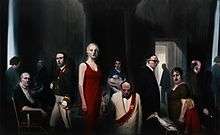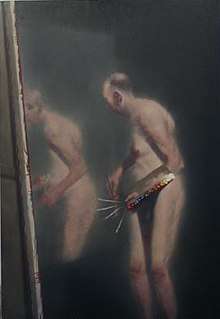Ken Currie
Ken Currie (born 1960 in North Shields, Northumberland, England) is a Scottish artist and a graduate of Glasgow School of Art (1978–1983). Ken grew up in industrial Glasgow. This has had a significant influence on his early works. In the 1980s Currie produced a series of works that romanticised Red Clydeside depicting heroic Dockworkers, Shop-stewards and urban areas along the River Clyde.[1][2] These works were also in response to then British Prime Minister Margaret Thatcher's policies that he believed were the greatest threat to culture of labour.
.jpg)
Ken Currie | |
|---|---|
| Born | 1960 (age 59–60) |
| Nationality | Scottish |
| Education | Glasgow School of Art |
| Known for | Painting, Printmaking |
Notable work | Three Oncologists, Portrait of Peter Higgs, Chimera |
Works

Currie's paintings show a profound interest in the body (physical and metaphorical) and the "terror" of mortality.[3] His works are primarily concerned with how the human body is affected by illness, ageing and physical injury. Closely related to these themes, his work also deals with social and political issues and philosophical questions. Although many of the images dealing with metaphysical questions do not feature figures, a human presence is nevertheless suggested.
He was labeled as one of the "New Glasgow Boys" along with Peter Howson, Adrian Wiszniewski and Steven Campbell who studied together at the Glasgow School of Art.[4]
His Glasgow History Mural was commissioned on the 200th anniversary of the Calton weavers massacre in 1787 and is displayed on the ceiling of the People's Palace.[5]
He has occasionally worked as a portraitist. Three Oncologists (2002) is in the collection of the Scottish National Portrait Gallery; it depicts Professor Robert J Steele, Professor Sir Alfred Cuschieri and Professor Sir David P Lane, three doctors from Ninewells Hospital, Dundee, in a "haunting", "spectral" painting that reflects the popular fear of cancer.[4]
Currie was commissioned by the University of Edinburgh to paint a portrait of Peter Higgs, the theoretical physicist, which was unveiled in 2009. He is a "reluctant portraitist", and this was only his second portrait.[6] He said, referring to the Higgs boson, "I am very interested in Peter's work. I don't for one second claim to grasp the theory, but I do understand the sublime, and there is a sublime quality to it all, a beauty, an awesome quality. In some respects, the subject is quite terrifying."[7]


Bibliography
Exhibition Catalogs
- Ken Currie: Tragic Forms [Catalogue of the exhibition held at Flowers 2016] London.
- Ken Currie: Immortality [Catalogue of the exhibition held at Flowers 2010] London.
- Ken Currie: Animals [Catalogue of the exhibition held at Flowers 2008] London.
Monographs
- Tom Normand, Ken Currie: Details of a Journey, Lund Humphries Publishers (1 June 2002), ISBN 0853318360
- Ken Currie, Ken Currie Painting & Sculpture, 1995–96, Panart Publishing Limited (1 January 1996) ISBN 1901340007
- Harrison, J. and Topp, G. (1995) Ken Currie: The Fourth Triptych and Other Works. Cleveland County Council.
References
- McGinty, Stephen (13 July 2013). "New artists 'neglect' hard graft, says Ken Currie". The Scotman. Retrieved 5 September 2018.
- "Profile on Ken Currie". The Essential School of Painting. 15 January 2015.
- "Interview: Ken Currie on 'the terror' of mortality". The Scotsman.
- Mcginty, Stephen (14 July 2013). "New artists 'neglect' hard graft, says Ken Currie". The Scotsman.
- Ken Currie. "THE GLASGOW HISTORY MURAL". Media Matters. Retrieved 5 February 2010.
- "A powerful driving force". Herald Scotland. Retrieved 28 April 2011.
- "Portrait of a man at beginning of time". The Times. Retrieved 28 April 2011.(subscription required)
External links
- Works in the National Galleries of Scotland
- Ken Currie's artist page on Flowers Gallery
- 34 paintings by or after Ken Currie at the Art UK site: works by Ken Currie in British public collections